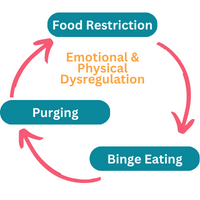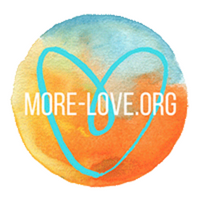
A guide for parents about eating disorder symptoms
Eating disorder behavioral symptoms include restricting, binge eating, over-exercise, purging, and body checking. These behaviors are typically a response to physical and/or emotional distress. Most eating disorder symptoms get more intense when your child is stressed.
It’s natural to want to stop the eating disorder behaviors as soon as possible, and that is sometimes medically necessary. But it’s important to keep in mind that eating disorder behaviors serve a purpose, as described below. That’s why in most treatment approaches your child will learn to replace their eating disorder behaviors with healthy coping behaviors rather than trying to stop cold-turkey style. The goal of eating disorder treatment is to build physical and emotional regulation skills so your child will no longer reach for their eating disorder behaviors.
Parent-Friendly ❤️ Neurobiology ❤️ Attachment ❤️ Non-Diet ❤️ Health At Every Size®
Eating disorder symptoms are self-reinforcing. This means that distress causes the behavior in the first place, then it “works,” so the person keeps using it. In an adaptive, healthy example, you feel hungry (distress) so you eat (behavior), and feel better (reinforcement). Thus you have reinforced a pattern of behavior: when I feel hungry, I eat.
In eating disorders this same pattern is in play: distress + behavior = reinforcement. The difference is that while the behaviors “work” to reduce distress, they have negative consequences and reinforce the eating disorder. These patterns become habitual and automatic. They are not a choice, but rather non-conscious and compulsive.
We don’t judge someone who reaches for a sweater when they are cold because it makes sense to us. We can bring the same level of understanding to someone with an eating disorder. An eating disorder relieves distress. With this understanding, we can help them soothe their distress in healthier ways. We can only motivate someone to recover from an eating disorder when we approach them with compassion, curiosity, and understanding.
Where this model comes from
Hi, I’m Ginny, the founder of More-Love.org. There are many different ways to see eating disorders. To create this model of the symptoms, I drew on academic research, interviews with treatment professionals, and hundreds of conversations with parents and people who have eating disorders. I look at eating disorders as a complex interaction of biology, psychology, and society. I’m particularly interested in the developing field of neurobiology, which gives us more information than we’ve ever had before about the brain-body connection. It reveals that the most confusing human behaviors are driven below the level of consciousness. I hope the days of blaming people for their symptoms will be in the past soon, because symptoms are signals. When we understand and work with them rather than fight them, we can make a difference.
Restricting

The cause of food restriction is emotional and physical distress. A person may start restricting food due to physical sensitivities to taste, smell, appearance, texture, sound, etc. Restriction may also be caused by less-active hunger cues and/or executive function issues that mean they don’t feed themselves when hunger cues are present. It may be due to nausea and/or a fear of vomiting. They may be highly sensitive to the physical sensation of fullness and want to avoid it. Finally, a very significant cause of restriction is a desire to lose weight.
Food restriction leads to both physical and emotional distress. In a restrict-only cycle, this distress leads to more restriction. Meanwhile, other cycles incorporate binge eating and purging behaviors before returning to restriction.
Symptoms of food restriction include:
- Restricting food quantity, type, timing, etc.
- Counting calories, macros, etc.
- Eating large quantities of vegetables instead of other foods
- Cutting out entire food groups like sugar, carbs, etc. (for non-allergy reasons)
- Anxiety about eating
- Refusing to eat
- Cooking/baking something and not eating it
- Lying about having eaten
- Hiding food to avoid eating it
Someone who is restricting may also frequently think and talk about food and what other people are eating. They may comment on family members’ food intake and try to dictate the family menu or prepare their own food. Also, they may follow a lot of food and diet accounts on social media.
Binge eating

In binge eating cycles, a person typically begins with restriction as described above. Binge eating episodes typically begin either with physical hunger and/or the belief that you can’t/shouldn’t eat. These events create a cascade of biologically-driven physical and emotional distress. A person who binge eats may also be less physically sensitive to sensations of fullness.
Binge eating typically results in physical discomfort and emotional shame. They will likely return to restricting to cope with this distress for as long as possible until restriction-driven physical and emotional distress leads to another binge eating episode. In this way, the cycle is reinforced.
Symptoms of binge eating include:
- Eating large quantities of food
- Food goes missing
- Sneak eating
- Lying about how much has been eaten
- Hiding evidence of binge eating episodes
Someone who has binge eating episodes is often desperately trying to be “good” by not eating. They may go for hours or an entire day in an attempt to make up for a binge the night before. This extreme restriction can lead to obsessive fantasies about food as well as a biological drive to eat (hunger is an adaptive feature of biology).
Purging

A purge cycle typically begins with restriction, which leads to binge eating, as previously described. But for this person, the physical and emotional distress of a binge eating episode leads to a purge. For some people, a binge eating episode is not clinically considered a binge, but it feels physically and/or emotionally substantial to them and therefore they purge after even small amounts of food.
Purging is a way to self-soothe or cope with the physical and emotional distress of restricting followed by eating. Additionally, vomiting triggers a powerful physical and emotional release, which further reinforces the behavior. After purging, the person will likely feel shame for having eaten food. To cope, they will return to restricting food for as long as possible until the cycle begins again.
Symptoms of purging include:
- Going to the bathroom during and immediately following meals
- Using laxatives
- Vomiting in the toilet, shower, baggies, and other containers or in bushes, curbs, corners, etc.
- Lying about having vomited, used laxatives, etc
Someone who purges may do so after an unexpected binge eating episode. Other times they may plan their binge and purge episodes.
Over-exercise

The degree to which exercise interacts with eating disorder symptoms varies. There are some eating disorders in which exercise is not a factor. And there are other eating disorders that are primarily exercise-based. Like other eating disorder behaviors, over-exercise is driven by distress, most often feelings of physical anxiety (the fight/flight response), and the belief that exercise will improve the body’s appearance and reduce weight. Symptoms of over-exercise include:
- Establishing a rigid exercise routine
- Exercising in secret
- Talking about exercise a lot
- Exercising more than is recommended by coaches, doctors, etc.
- Insisting on exercising every day and on vacation, holidays, and other times when most people would take a break
- Lying about how much exercise they’ve done
- Using dietary supplements to increase the results of exercise
Someone who is engaging in over-exercise may also frequently think and talk about how other people exercise. For example, they may follow “fitspo” social media accounts.
Body Checking

Body checking is a symptom of most eating disorders. Like other eating disorder behaviors, it is driven by distress, typically anxiety about appearance and negative body image. Body checking is a way a person who is feeling body image anxiety tries to reassure and soothe themselves. Unfortunately, body checking is a self-reinforcing cycle. The more a person body checks, the worse they feel and therefore the more they will body check. Symptoms of body checking include:
- Weighing
- Pinching
- Touching bones (collarbones, hip bones, ribs, wrists, etc.)
- Measuring
- Trying on many different outfits and taking a long time to get dressed
- Looking in mirrors and other reflective surfaces
- Critically evaluating individual body parts
- Asking for feedback on appearance and body parts
- Talking about their body a lot
Someone with a lot of body checking symptoms may also frequently think and talk about other people’s bodies. For example, they may follow “body inspiration” social media accounts.
What is “physical and emotional dysregulation?” A regulated system is one that is functioning well and as expected. A dysregulated system is not running smoothly or as expected and is over- or under-reacting to triggers. Physical dysregulation may be triggered by sensations of hunger, fullness, nausea, no appetite, etc. Emotional dysregulation is both brain- and body-based, so it can include racing thoughts and feelings like rage, fear, and worry. And it can create in-body sensations of flight, fight, and freeze that can feel like agitation and amplification or heaviness, numbness, and disconnection.
Parent Scripts For Eating Disorder Recovery
Use these scripts:
- At the dinner table when behavior is getting out of control
- When you need to set boundaries – fast!
- After something happened so you can calmly review the triggers and events
< Return to eating disorder causes
Go to types of eating disorders >
free cheat sheet: Parenting A Child With An Eating Disorder
⭐ Get ready for recovery and find out how you can prepare yourself for maximum success.
⭐ Find out the essential steps and family rules you need to have in place for recovery.
⭐ Make your home recovery-ready with six simple steps that anyone can do.
Articles About Eating Disorder Symptoms and Behaviors
Quiz: Does my child have an eating disorder?
Take this quiz to evaluate your child’s behavior and whether there is reason to suspect an eating disorder.









